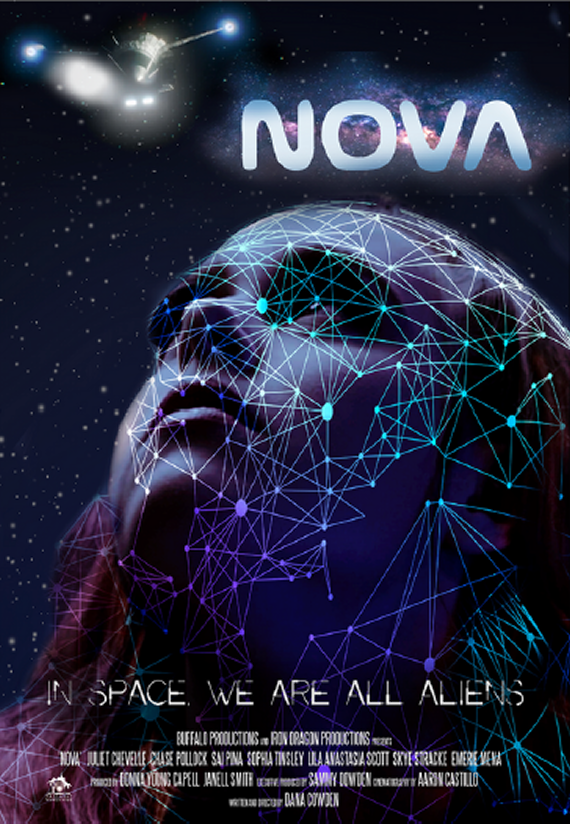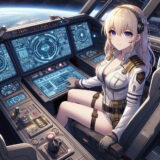Steve Fahnestalk’s Amazing Stories Column 348

Hey, happy Friday to you all. I hope it’s just a normal Friday and not a TGIF, meaning you’ve had a tough week. We Canadians (and many in the former British Empire) will have a day of mourning on Monday for the late Queen Elizabeth II, and I hope those of you in the US take a moment to remember the longest-serving monarch of the last couple of centuries. As head of state, her duties were mostly ceremonial, but she did her best to “serve the country and its people.” Can’t ask for much more, can you?
Now we come to the main part of this column: coming (from distributor TriCoast Worldwide) to streaming on Sunday (Amazon Prime, Vudu, iTunes, Google Play, and more) is a new SF movie called Nova. I want to caution you not to expect scientific rigour from this movie, as it’s more an idea movie than an actual “science” fiction film. The idea is not new, even dressed in the tropes of SF; in fact, they go all the way back to the first story to even use the word “robot.” (Actually, I think the word used was “roboti,” which is a derivative of the Czech word for “worker.” The story, of course, was Karel Čapek’s 1920 story R.U.R. (Rossum’s Universal Robots.) In this story (and the 1938 TV movie made from it) the robots revolt and attempt to wipe out the humans. (It’s been years, so I can’t remember if they succeed. I could Google it, but that would be cheating.) Then there are the stories, books, and movies about robots/androids that either become human, become nearly human, or fall in love with humans (for example, Isaac Asimov’s Bicentennial Man; Lester del Rey’s Helen O’Loy; and Brian Aldiss’s Supertoys Last All Summer Long, movie-ized as Steven Spielberg’s A.I.). So the idea isn’t new.
By the way, the convention around the difference between robots and androids has changed over the years. Both robots and androids—talking now about humanoid artificial people, rather than industrial “shaped for the purpose machines”—has become that robots are mechanical, and although humanoid, shaped vaguely like humans, they don’t have to look precisely like humans. Androids look exactly like humans, and they can be mechanical or biological. Both have been made by humans and usually to serve humans; either to do tedious or dangerous work that humans can’t or won’t do, or as literal slaves that can be treated like property because they aren’t human. Some androids are made for research purposes, to see how close to human we can make an artificial being. In most cases, however, whether they are intelligent enough to have “free will” (whatever that really means) or whether they are somewhat “dumb brute-ish”, they are made to serve Man (and let’s have no Damon Knight or Twilight Zone jokes here, please).
Moviemaker Dana Cowden has written and directed this movie about a military mission to Mars with a crew of several androids and four humans. The humans include Captain Rennie Flynne — Leila Anastasia Scott; the civilian scientist/roboticist genius “Abilene” Lamb — Chase Pollock; a Ph.D. who’s going to Mars to find uranium, Doctor Martin Callahan — Ian Wilson; and his approximately 11-year-old precocious daughter, Lynae Callahan — Emerie Mena. They don’t expect to be on Mars for very long; they’re joining a military mission already on Mars. The captain dislikes and is very suspicious of Abilene’s androids—he designed and built them all. Abilene loves his androids, especially Nova, who’s been with him for years, and is going to Mars to get away from people. I can’t remember why the Doctor is taking his daughter; he and she have filled their cabin with plants, and she monitors their health and adjusts their pH balance by adding trace elements to their water.
The androids include Reese (Skye Stracke), who likes to “improve” herself and her fellow androids without waiting for Abilene’s permission (she also has an Australian accent—the only one on board, for some reason); Nova (Juliet Chevelle), who’s been with Abilene for years and has an attachment to him; Una (Charlie Han), the newest one; and Troy (Sai Piña), the only male android, who actually doesn’t get finished until very late in the movie. One way you can tell when someone’s an android (if they’re female) is that they have a lot of hair and extremely long fake eyelashes.
As I said before, don’t expect a lot of real science in this SF movie—for example, the ship doesn’t rotate, yet they seem to have Earth-normal gravity. The stars seen through the bridge windows seem to twinkle somewhat. There is an emergency during the flight—a solar flare which despite being strong enough to burn out all the satellites and space stations around Earth, doesn’t destroy the ship, because “the shielding is strongest around the flight deck.”
The stage is set—after the solar flare, their external antennas are burned off (and something else that runs on the outside of the ship is damaged); Abilene says his androids can go outside and fix that stuff—but they don’t have the spare parts, except they can build short-range antennas to communicate with Mars; Earth will be incommunicado for years because all the comm satellites are destroyed by the flare. Nova is supposed to be the Executive Officer, but Captain Flynne won’t let her, because she doesn’t believe Nova has a sense of responsibility; besides, machines malfunction. Reese, meanwhile, has been upgrading Nova’s hardware on the sly, and Nova can now communicate with any of the ship’s systems “within a hundred meters.” The ship’s computer, btw, is called “Darwin” (voice of Miles Blunt) and only appears a few times.
Here’s the crux of the story: Reese doesn’t trust the humans (“Humans lie,” she says) and after Captain Flynne orders Una destroyed—there’s a reason, but I won’t reveal it here—Reese decides the humans are murderers and want to enslave all the androids. You can guess where it goes from here in terms of conflict. I thought the conflict wasn’t badly handled, but you can only put so much into an 85-minute film. More character development might have been better instead of so much build-up. Anyway, unless bad science drives you crazy, it’s worth a watch. Since the actors are all relative unknowns, I don’t think they did a bad job; we’re not talking Hamlet here. I think Reese had the best chance to emote; Nova was not the most emotive character on board—of course, Reese had installed emotion software in her, but she was integrating it as the film progressed. The ending was not a surprise to anyone who reads a lot of SF or watches some real SF (not Marvel superhero movies) films.
Comments? Arguments? Brickbats? You can comment here or on Facebook, or even by email (stevefah at hotmail dot com). All comments are welcome! (Just be polite, please.) My opinion is, as always, my own, and doesn’t necessarily reflect the views of Amazing Stories or its owner, editor, publisher or other columnists. See you next time!











Recent Comments